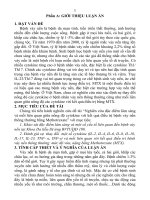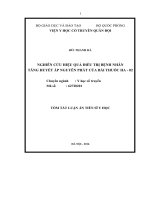Nghiên cứu hiệu quả điều trị bệnh vảy nến thông thường có hội chứng chuyển hóa bằng Methotrexate kết hợp với Metformin (TT ANH)
Bạn đang xem bản rút gọn của tài liệu. Xem và tải ngay bản đầy đủ của tài liệu tại đây (405.58 KB, 48 trang )
MINISTRY OF EDUCATION
MINISTRY OF NATIONAL DEFENCE
AND TRAINING
108 INSTITUTE OF CLINICAL MEDICAL AND PHARMACEUTICAL SCIENCES
HUYNH THI XUAN TAM
STUDYING THE EFFECTIVENESS OF THE COMBINED USE OF
METHOTREXATE AND METFORMIN ON PSORIASIS
CONCOMITANT WITH METABOLIC SYNDROME
Major: Dermatology
Code: 62.72.01.52
EXECUTIVE SUMMARY OF THE DISSERATION
Hà Nội – 2020
The study was accomplished at:
108 INSTITUTE OF CLINICAL MEDICAL AND
PHARMACEUTICAL SCIENCES
Instructors:
1. Bui Thi Van MD. Ph.D.
2. Tran Ngoc Anh MD. Ph.D.
Dissertation Committee:
1.
2.
3.
The dissertation will be protected in a council meeting
at: 108 Institute of Clinical Medical and
Pharmaceutical Sciences
At hour Day
Month
Year 2020
The dissertation can be found in:
1. National library of Vietnam
2. Library of 108 Institute of Clinical Medical and
pharmaceutical Sciences
3. Central institute for Medical Science
Information and Technology
1
INTRODUCTION
Psoriasis
is
one
of
the
most
common
dermatological condition which 1-3% population got
around the world. This percentage varies in races and
regions. For example, psoriasis in Northern Europe was
reported up to 3%, higher than the United States of
America and China with 2% and 0.3% respectively. In
Viet Nam, until now there has been a serious dearth in
research on the prevalence of this disease, just a few
studies operated in Kinh Mon district, Hai Duong
province showed this figure being 1,5% of population.
Psoriasis in the obese Vietnamese shows the
overexpression
of
inflammatory
factors
and
adipocytokines including cytokines IL-6, TNF-α,
adiponectin, and PAI-1. The level of TNF-α increases in
patients with psoriasis, and is positively correlated to the
BMI and insulin resistance.
Controlling metabolic syndrome in patients with
psoriasis is essential to reduce disease burdens.
However, treating psoriasis associated with metabolic
2
syndromes
faces
many
challenges
because
of
controversial pathology, progression and clinical
evidence.
Research on using the combination of methotrexate
and metformin in psoriasis and metabolic syndrome has
been done around the world but not in Vietnam so for.
Therefore, it is necessary to conduct research on this
type of treatment in Vietnam with the following
objectives:
1. To describe some relating factors and clinical
features of psoriasis concomitant with metabolic
syndrome.
2. To survey the metabolic syndrome in psoriasis
patient and its relationship with clinical features.
3. To identify the effectiveness of the combination
of methotrexate and metformin in the treatment of mild
and moderate psoriasis.
3
Chapter 1: INTRODUCTION
1.1. Clinical and subclinical features of psoriasis:
1.1.1. Clinical features:
- Cutaneous lesion: A specific lesion is a non-infiltrated,
erythematous, well-defined plaque with silvery scales
on the surface. The size of the lesion can vary from
pinpoint papules to plaques covering large area of the
body. Psoriasis has a tendency to be symmetrical, which
is a good characteristic for diagnosis. However,
unilateral lesion can also appear. Common lesions
include: macules, plaques of erythema and scale
(sometime papules with scale).
- Sites of lesion: Lesions are generally symmetrical. The
sites of predilection of the characteristic plaques include
scalp, beyond the hairline, knee, elbow, extensor of the
arms and legs. Psoriasis lesions can appear on cutaneous
injuries, irritation, rubbing (for example scratching,
chafing, injection) called Kebner phenomenon.
- Nail lesions: Nail lesions are very common (30-50%
of all cases). It happens in all or many nails
4
symmetrically. The prevalent feature is the thickening of
nails or subungual hyperkeratosis. The surface of the
nails isn’t shiny and has pitting or grooves across.
1.1.2. Subclinical features:
- Histologic findings: acanthosis of the epidermis,
parakeratosis and vascular dilation.
- Other tests: Mild anemia is commonly reported among
psoriasis patients. There is an increase in the risk of
arthritis due to Gout. Nitrogen balance is negative,
presenting low albumin in the serum. The level of Creactive protein, α2-macroglobulin and erythrocyte
sedimentation rate rises, which indicates systemic
inflammation.
1.2. Psoriasis and metabolic syndrome:
A number of recent research studies on lipid
disorders
showed
ununiformed
results
across
geographies and races. These studies showed a strong
correlation between psoriasis and lipid disorder.
A systemic review from literature on “Psoriasis and
metabolic syndrome” by Rita Sales, Tiago Torres from
5
Portal university, Portugal pinpointed that psoriasis is
positively correlated to metabolic disorder. Psoriasis
should not be considered as a simple skin condition but
a systemic inflammatory illness concomitant with some
diseases, e.g. an increased likelihood of cardiovascular
illness. Doctors should be alerted to this syndrome and
find it beside skin condition. It is important to screen for
the proofs of metabolic disease and control them tightly.
All psoriasis patients are advised to change their
lifestyles and do exercise more frequently.
With the objective to evaluate the serum lipid in
psoriasis patients, Nguyen Trong Hao and Tran Hau
Khang conducted a case-control study on 80 psoriasis
patients and 80 healthy people. Diagnosis of psoriasis
was based on clinical and pathological features. Both
group had lipid profile calculated (triglyceride,
cholesterol, HDLc, LDLc). The results showed that
patients had a higher triglyceride (p = 0.03) and lower
HDLc (p = 0.0009) in comparison to that of healthy
people. The authors concluded that it is necessary to
6
screen and treat lipid disorder as soon as possible to
prevent atherosclerosis and its complications.
1.3. Methotrexate and Metformin in the treatment of
psoriasis with metabolic syndrome:
1.3.1. Methotrexate
- Effect on DNA synthesis: MTX competitively and
reversibly binds to dihydrofolate reductase within 1
hour, with an affinity greater than that of folic acid.
This prevents the conversion of dihydrofolate to
tetrahydrofolate. Tetrahydrofolate is a necessary cofactor in the production of 1-carbon units, which are
critical for the synthesis of thymidylate and purine
nucleotides needed for DNA and RNA synthesis. A
less rapid, but partially reversible, competitive
inhibition of thymidylate synthetase also occurs within
24 hours after administration of MTX
- Effect on T lymphocytes: Jeffes et al. demonstrated in
an in vitro experiment that the effect of MTX on the
proliferation of lymphoid cells is 1000 times greater
than its effect on human keratinocytes. Not only does
7
MTX affect the proliferation of lymphocytes, it also
blocks migration of activated T cells into certain tissues.
- Immunosuppression: The effect probably occurs
because
of
inhibition
of
DNA
synthesis
in
immunologically competent cells. The drug can
suppress primary and secondary antibody responses.
- Anti-inflammatory effect: the anti-inflammatory
effects are predominantly mediated by adenosine. This
increased adenosine production is the result of a
complex interaction with AICAR transformylase and
ecto 5′ nucleotidase.
1.3.2. Metformin
Metformin is an oral diabetes medicine in
biguanide group that helps control blood sugar levels. It
cannot decrease sugar level in normal person. In
diabetes patients, metformin improves blood sugar
control but do not cause hypoglycemia (unless the
patients starve themselves or using other drugs for
diabetes treatment). Metformin act through activation of
adenosine monophosphate-activated protein kinase
8
(AMPK) in extracellular signal-related kinase (ERK1/2)
signaling pathway leading to cell cycle arrest and
therefore inhibition of cell proliferation, hallmark of
psoriasis. AMPK activation not only inhibits iNOS,
dendritic, and T cell and monocyte/macrophage
activation but also activates IL-10 and TGF-β, thereby
exerting its anti-inflammatory action. The antiproliferative and anti-inflammatory effects of metformin
might have resulted in reduction of psoriasis.
1.3.3. Using Metformin and Methotrexate on psoriasis
patients.
Hartmut Glossmann et al highlighted that
Metformin is a good therapy in combination with
methotrexate in the treatment of male patients with
psoriasis concomitant with obesity and metabolic
syndrome. Scientists have the evidence supporting the
theory in which the anti-inflammatory effect of
metformin can combine with methotrexate and reduce
its hepatotoxicity in experimented animals. This
9
suggests for the doctors that using metformin can protect
the liver from methotrexate in psoriasis patients
10
Chapter 2
MATERIALS AND METHODS
2.1. Objectives and materials
2.1.1. Objectives:
From 6/2016 to10/2018, we chose 66 patients with
plaque psoriasis diagnosis being treated in Ho Chi Minh
city Hospital of Dermatology and Venereology. All of
them have enough criteria to participate in the research.
2.1.1.1. Diagnostic criteria:
- Psoriasis diagnostic criteria: The diagnosis is based
on clinical features. To be specific, the lesions are
erythematous plaques with scales on the surface and
some suggestive characteristics: circumscribed border,
non-inflitration, sites of predilection, mild or severe
priritus and silvery scales.
- Metabolic syndrome diagnostic criteria: According to
the criteria of NCEP ATP III and SAM-NCEP, the
diagnosis is establised when 3 on 5 factors appear.
Table 2.1: Risk factors of metabolic syndrome:
11
Factors
Waist circumference
Triglyceride
Values
≥ 90cm in males and ≥
80cm in females
≥ 150mg/dl (1,7mmol/L)
40mg/dl (0,9mmol/L) in
HDL-C
males
and
50mg/dl
(1,0mmol/L) in females
Systolic
Hypertension
pressure
≥
130mmHg
or diastolic pressure ≥
85mmHg
Fasting glucose
≥ 100mg/dl (5,55 mmol/L)
2.1.1.2. Inclusion criteria:
- Patient with psoriasis vulgaris and metabolic syndrome
with the age between 18 and 70.
- Patients are non-alcoholic and liver, kidney function
tests are normal.
- Accept to participate in the research.
12
2.1.1.3. Exclusion criteria:
- Pregnancy and lactation.
- Patient have been using systemic drug to treat psoriasis
such as: cyclosporine, retinoid, or immunologic therapy
for one month.
- Having acute or chronic infection.
- Contraindication to use metformin and methotrexate.
2.1.2. Materials:
- Drugs:
+Metformin: tablet, proprietery name is Fodia, the
dosage is 500mg/1 pill, manufactured by United
International Pharma CO. LTD. Drug lot 617551,
expired in 11/2019.
+Methrotrexate: tablet, proprietery name is Unitrexate,
the dosage is 2.5mg/1 pill, manufactured by Korea
United Pharm.Inc, distributed by Song Việt Pharmacy.
Drug lot E736615, expired in 04/2019.
+ Axit folic: proprietery name is Folacid, the dosage is
5mg/1 pill. Manufactured and distributed by Pharmadic
13
( Drug
lot 0080716, 0090716, expiration day 7/2019.
- Test forms: Cholesterol, Triglyceride, Glucose.
- Tape measure for waist circumference, height chart
wall sticker for height
- Camera (to take picture typical psoriasis patient).
2.2. Methods:
2.2.1. Study design
- Objective 1:
Prospecive, cross-sectional study to
describe some relating factors and clinical features of
psoriasis with metabolic syndrome
- Objective 2: Prospecive, cross-sectional study to
evaluate the metabolic syndrome in psoriasis vulgaris
patient and its relationship to the clinical features.
- Objective 3: Prospective, randomized placebo control
study to evaluate effectiveness of the combination
between methotrexate and metformin.
2.2.2. Sample size:
- Convenient sampling for 3 objectives: Choosing every
patient that meets the including creteria attended to
14
HCMC Hospital of Dermatology and Venereology from
6/2016 to 2/2018.
- Choosing method: every psoriasis vulgaris patient that
meets the including creteria attended to HCMC Hospital
of Dermatology and Venereology. Objective 3: devided
patients into 2 groups acccording to their odd and even
order but there was no difference in age, sex and disease
severity.
2.2.3. Steps:
- Building sample clinical record (Data collection form)
Objective 1 and 2:
- Choosing qualified patients: examing, liver, kidney
function test, lipid profile, fasting blood sugar.
- 66 psoriasis patients met the including criteria were
asked for history, examined, PASI evaluated, measured
height, weight, waist circumference, blood pressure and
lipid profile.
Objective 3:
- Psoriasis patients with metabolic syndrome chosen
were devided into 2 groups:
15
Treatment group: 33 psoriasis vulgaris patients
with metabolic syndrome were treated by metformin +
methotrexate, and
Control group: 33 psoriasis vulgaris patients with
metabolic syndrome were treated by methotrexate only.
- Treatment procedure:
+ Treatment group:
Methotrexate: start with 10 mg/week, 15 mg in second
week, and sustain in three months (12 weeks). drug is
used weekly, devided into 2 doses q12hr.
Metformin: 500mg/day after meal.
+ Control group:
Methotrexate only with the same dosage and usage
- Result evaluation: both groups were evaluated:
+ Treatment results were evaluated by PASI before
treatment, after treatment 1 month, 2 months, 3 months.
+ Blood samples were taken to test full blood count, ure,
creatinin, AST, ALT, GGT, cholesterol, triglyceride,
fasting glucose before and 3 months after treatment. The
indexes of AST, ALT, GGT, triglyceride, total
16
cholesterol, HDL-C were measured by HumaStar 600
machine with Enzyme kenetic. The tests were conducted
in the laboratory of HCMC Hospital of Dermatology
and Venereology.
+ To evaluate side effects through clinical features, test
indexes and cutanous eruption.
2.2.4. Techniques and evaluation criteria
2.2.4.1. Evaluating the severity through PASI
Evaluating the severity through PASI (Psoriasis
area and severity index). Mild: PASI: < 10, Moderate:
PASI: 10 - < 20, Severe: PASI: ≥ 20.
- PASI calculating: the area and intensity of psoriasis:
PASI=0,1(E+D+I)Ah+0,2(E+D+I)Au+0,3(E+D+I)At+
0,4(E+D+I)Al
In which:
+ Area: 0,1+0,2+0,3+0,4 = 1
To be specific: Head: 0,1, upper limbs: 0,2, trunk: 0,3,
lower limbs: 0,4
+ Intensity: Erythema (E); Desquamation (D);
Infitration (I).
17
Every criteria (E, D, I) was divided into 5 levels (0 - 4).
Very severe: 4; Severe: 3; Moderate: 2; Mild: 1; Absent:
0.
+ Area - A: Head (H); Trunk (T); Upper limds
(U); Lower limds (L).
Every area was devided into 5 levels (0-6): 0: 0%; 1: 19%; 2: 10-29%; 3: 30-49%; 4: 50-69%; 5: 70-89%; 6:
90-100%.
2.2.4.2. Evaluating the treatment result:
Clinical effects were measured by % PASI
reduction according to equation of Heng-Leong Chan in
1993:
% PASI reduction = PASI before treatment - PASI after
treatment/PASI before treatment x 100
Based on PASI reduction, there are 4 levels:
Very good
: PASI reduces100%
Good
: PASI reduction ≥ 75%
Moderate
50 - < 75%
: PASI reduction
18
Medium
: PASI reduction
25 – 50%
Bad, no effectiveness
: PASI reduction
< 25%
2.2.5.3. Evaluating side effects:
- Noting side effects such as fatique, headache,
anorexia,...
- Urticaria, pruritus, petachie,...
- Test result AST, ALT, ure, creatinin, HC, BC, TC
before and 3 months after treatment.
2.3. Data analysis:
Entering and analysing data with Stata 12 software.
The data was demonstrated by frequency, percentage,
medium, standard deviation, median.
Using χ2 to identify the relationship for qualitative
variables or Fisher’s exact test when > 20% expected
frequency in the table < 5, counted OR with 95%
interval and analysed variance by ANOVA test.
19
For quantitative variables with normal distribution,
we used t-Test to compare 2 average values and
ANOVA variance analysis to compare more average
values. For quantitative variables with abnormal
distribution, we used Wilcoxon Two-Sample Test.
2.4. Location and duration:
- Location: HCMC hospital of Dermatology and
Venereology.
- Duration: From 6/2016 to 2/2018.
20
Chapter 3: RESULT
3.1.
Some
relating
factors
and
the
clinical
characteristics of psoriasis vulgaris and metabolic
syndrome.
- Sex distribution:
Chart 3.1. Sex distribution (n = 66)
Note: The proportion of male was 59,1%, higher than
that of female, with 40,9%.
- Age distribution:
21
Chart 3.2. Age distribution (n = 66)
Note: In psoriasis patients with metabolic syndrome, the
age 40 – 59 took the highest percentage, with 54,5%,
followed by that of ≥ 60 with 30%. At the lowest
percentage was the age < 40, with the figure being
15,2%.
- Age of onset and duration:
22
Chart 3.4. Age of onset distribution (n = 66)
Note: The age of onset below 40 was higher than that
above 40, with 54.5% compared to 45.5%
Chart 3.5. Duration distribution (n = 66)
Note: At the top percentage was the 11-20 years
duration, with 40.9%. The percentages ≤ 10-year
23
duration and > 20-year duration were relatively equal, at
roughly 30% each.
- Severity distribution:
Chart 3.7. Severity distribution (n = 66)
Note: The figure for moderate psoriasis was higher than
that for severe ones, 53% and 47% respectively.
- The relationship between the age of onset and some
factors:
Table 3.5: The relationship between the age of onset
and some factors: (n = 66)
The age of onset
Gender
< 40
≥ 40
n (%)
n (%)
p
p < 0,05









